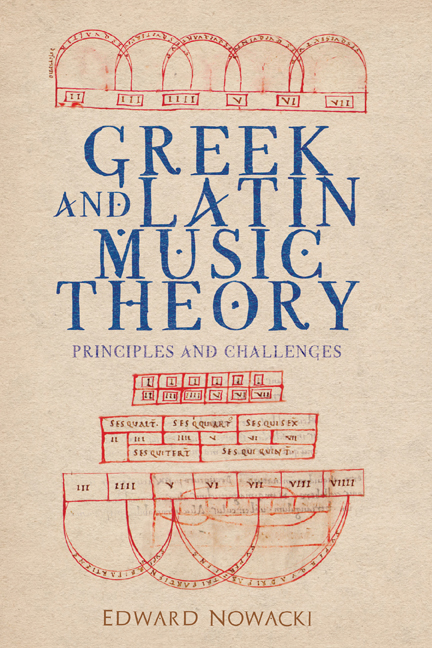6 - Aristoxenus's Proof That the Perfect Fourth Is the Sum of Two Tones and a Semitone
Published online by Cambridge University Press: 14 August 2020
Summary
The following thought experiment occurs at the end of the second book of Aristoxenus's Elementa harmonica (late fourth century, B.C.E.). For centuries it was a target of criticism by theorists wishing to point out Aristoxenus's lack of Pythagorean rigor. It embodies in a nutshell his distinctive way of practicing the discipline of music theory.
• Take a fourth, A–B.
A————————B
Aristoxenus's experiment can only be conducted in the imagination. In a real experiment, such as those based on Pythagorean principles, points such as A and B have no sound in themselves; they are only the terminal points of various spans, such as A–X and B–X.
A———B——————————X
You produce pitch by causing those entire spans to sound on a string or some other sound-source. A perfect fourth would be the difference between the two spans, A–X and B–X, not the space between A and B.
• Within the span A–B find the ditone below B and label it C, and find the ditone above A and label it D. Observe that the two remainders, A–C and D–B, are equal, because they are the result of subtracting equals from equals.
A——C———————D——B
Earlier in book 2 Aristoxenus describes the method of finding ditones “by means of concords.” It requires tuning a fifth, then a fourth in the opposite direction in order to obtain the difference of a tone, then repeating the procedure to obtain a second tone. The assumption is that ditones, as all discords, occur within certain ranges of acceptable variation, whereas concords—fourths and fifths—having no locus of variation, can be judged exactly.
• Next measure a fourth below D and label it E and a fourth above C and label it F, and observe that E–A and B–F are the differences between a ditone and a perfect fourth. All four differences, E–A, A–C, D–B, and B–F, are therefore equal.
E——A——C————————D——B——F
• Now sound the interval E–F and observe that it is a concord. Since it is greater than a fourth and less than an octave, it must be a fifth, since that is the only concord between the fourth and the octave.
- Type
- Chapter
- Information
- Greek and Latin Music TheoryPrinciples and Challenges, pp. 60 - 62Publisher: Boydell & BrewerPrint publication year: 2020

